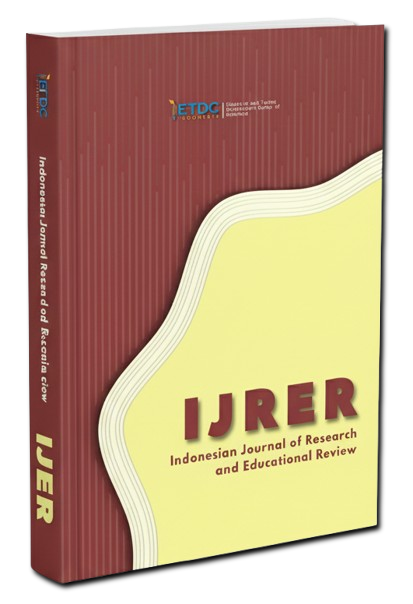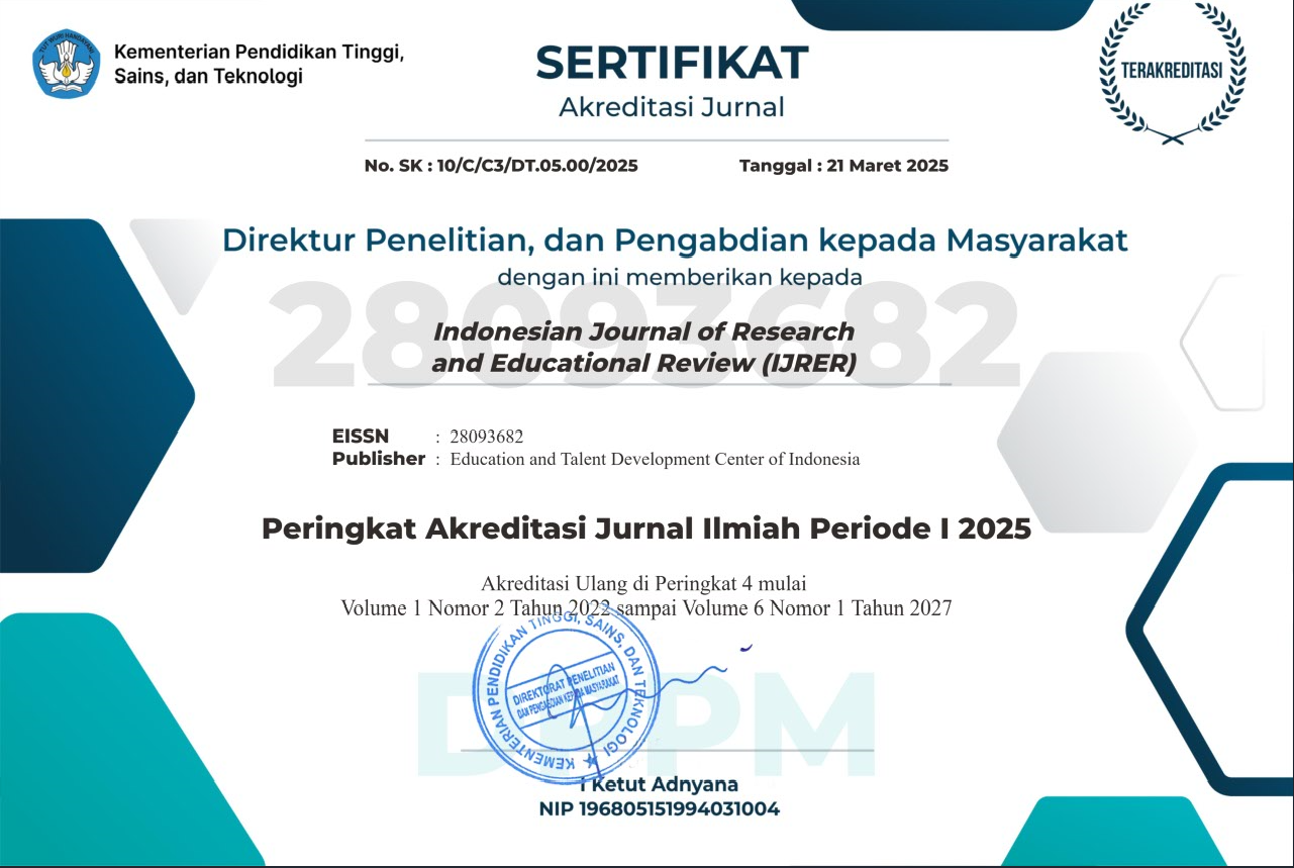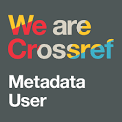Inhibiting Factors for Learning PJOK Online Volleyball Material at Elementary School
DOI:
https://doi.org/10.51574/ijrer.v3i4.341Keywords:
Elementary School, Learning, PJOK, VolleyballAbstract
This study aims to determine the factors that inhibit PJOK learning of volleyball material during the Covid-19 pandemic at MIS Al-Hikmah Gempolmanis, Lamongan Regency, East Java. This study employs a descriptive-quantitative approach, utilizing a survey method. The study's population consisted of 42 students from class IV at MIS Al-Hikmah Gempolmanis. The total sampling technique was used in this study. The instrument used was a questionnaire test with a validity of 0.964 and a reliability of 0.981. The data analysis technique used descriptive analysis, which was expressed in the form of a percentage. The results of the study showed that the inhibiting factors for learning PJOK volleyball material during the Covid-19 pandemic at MIS Al-Hikmah Gempolmanis, Sambeng District, Lamongan Regency were in the categories of "very low" 0.00% (0 students), "low" 0.00% (0 students), "sufficient" 21.43% (9 students), "high" 71.43% (30 students), and "very high" 7.14% (3 students).
References
Adedoyin, O. B., & Soykan, E. (2023). Covid-19 pandemic and online learning: the challenges and opportunities. Interactive learning environments, 31(2), 863-875.
Anugrahana, A. (2020). Hambatan, solusi dan harapan: pembelajaran daring selama masa pandemi covid-19 oleh guru sekolah dasar. Scholaria: Jurnal Pendidikan Dan Kebudayaan, 10(3), 282-289.
Azhari, B., & Fajri, I. (2022). Distance learning during the COVID-19 pandemic: School closure in Indonesia. International Journal of Mathematical Education in Science and Technology, 53(7), 1934-1954.
Babbar, M., & Gupta, T. (2022). Response of educational institutions to COVID-19 pandemic: An inter-country comparison. Policy Futures in Education, 20(4), 469-491.
Biwer, F., Wiradhany, W., Oude Egbrink, M., Hospers, H., Wasenitz, S., Jansen, W., & De Bruin, A. (2021). Changes and adaptations: How university students self-regulate their online learning during the COVID-19 pandemic. Frontiers in psychology, 12, 642593.
Clemente-Suárez, V. J., Navarro-Jiménez, E., Moreno-Luna, L., Saavedra-Serrano, M. C., Jimenez, M., Simón, J. A., & Tornero-Aguilera, J. F. (2021). The impact of the COVID-19 pandemic on social, health, and economy. Sustainability, 13(11), 6314.
Erfayliana, Y., Demirci, N., & Demirci, P. T. (2022). Developing online modules for educators in fifth grade physical education class. JUMORA: Jurnal Moderasi Olahraga, 2(1), 23-37.
Fadhilah, M., Sutrisna, S., Muslimah, S. N., & Ihsan, M. T. (2021). An exploring methods in online learning: Synchronous and asynchronous. ETDC: Indonesian Journal of Research and Educational Review, 1(1), 74-81.
Haryanti, A., Yusuf, M., & Agung, L. (2021). Students’ Perceptions About the Use of Android-Based Learning Media in Physical Education Learning. AL-ISHLAH: Jurnal Pendidikan, 13(2), 836-842.
Jelena, M. (2023). Competences of Physical Education Teachers in Education Supported by Digital Technology. International Journal of Cognitive Research in Science, Engineering and Education, 11(2), 331-341.
Kang, N. H. (2008). Learning to teach science: Personal epistemologies, teaching goals, and practices of teaching. Teaching and teacher education, 24(2), 478-498.
Kenny, B. J., & Gregory, C. R. (2015). Volleyball: Steps to success. Human Kinetics.
Khamidi, A., & Hartoto, S. (2022). Management physical education learning model in the era of the covid-19 pandemic: A literature review. Jurnal SPORTIF: Jurnal Penelitian Pembelajaran, 8(1), 96-117.
Kusuma, R. J., Atrup, A., Pratama, B. A., & Daulay, D. E. (2023). Development of Interactive Media for Physical Education, Sports, and Health Subjects in Junior High School. Journal Coaching Education Sports, 4(2), 267-276.
Lassoued, Z., Alhendawi, M., & Bashitialshaaer, R. (2020). An exploratory study of the obstacles for achieving quality in distance learning during the COVID-19 pandemic. Education sciences, 10(9), 232.
Littlejohn, A. (2023). Transforming educators’ practice: How university educators learned to teach online from home during the Covid-19 pandemic. Higher Education Research & Development, 42(2), 366-381.
Ma, K., Chutiyami, M., Zhang, Y., & Nicoll, S. (2021). Online teaching self-efficacy during COVID-19: Changes, its associated factors and moderators. Education and information technologies, 26(6), 6675-6697.
Padli, P., Kiram, Y., Arifianto, I., Setiawan, Y., Haryanto, J., & Lesmana, H. S. (2022). The effect of online-based assignment responses and student creativity in PJOK during pandemic in rural and urban area. Jurnal Keolahragaan, 10(1), 127-136.
Panigrahi, R., Srivastava, P. R., & Sharma, D. (2018). Online learning: Adoption, continuance, and learning outcome—A review of literature. International Journal of Information Management, 43, 1-14.
Pratiwi, J. A., Rosalina, N., Rodiah, N., & Ervina, W. (2021). The Performances of Synchronous and Asynchronous Method in Teaching and Learning English. ETDC: Indonesian Journal of Research and Educational Review, 1(1), 46-57.
Rasmitadila, R., Rachmadtullah, R., Samsudin, A., Nurtanto, M., & Jauhari, M. N. (2023). Limited face-to-face learning on students in inclusive classrooms during the Covid-19 pandemic: Perceptions of elementary school teachers in Indonesia. Cogent Education, 10(1), 2213612.
Ridwan, R. (2023). Impact of large-scale social restriction policy on the economy in Depok City, West Java province. JPPI (Jurnal Penelitian Pendidikan Indonesia), 9(3), 1291-1296.
Sartika, F., Ritonga, M., Lahmi, A., Rasyid, A., & Febriani, S. R. (2021). Online learning in the low Internet area, planning, strategies and problems faced by students during the Covid-19 period. Artificial intelligence for COVID-19, 413-421.
Singh, J., Steele, K., & Singh, L. (2021). Combining the best of online and face-to-face learning: Hybrid and blended learning approach for COVID-19, post vaccine, & post-pandemic world. Journal of Educational Technology Systems, 50(2), 140-171.
Sokoy, F. (2024). Legal Perspective in the Curriculum of Physical Education, Sports, and Health in Indonesia. ACTIVE: Journal of Physical Education, Sport, Health and Recreation, 13(2).
Stoian, C. E., Fărcașiu, M. A., Dragomir, G. M., & Gherheș, V. (2022). Transition from online to face-to-face education after COVID-19: The benefits of online education from students’ perspective. Sustainability, 14(19), 12812.
Syafaruddin, B., Ruhaya, B., & Jamal, J. (2022). Problems of Learning Planning in The Time of The Covid Pandemic 19. ETDC: Indonesian Journal of Research and Educational Review, 1(2), 122-128.
Tønnessen, Ø., Dhir, A., & Flåten, B. T. (2021). Digital knowledge sharing and creative performance: Work from home during the COVID-19 pandemic. Technological Forecasting and Social Change, 170, 120866.
Vascellari, A., Poser, A., Rossi, A., Rosini, T., Bertocco, R., & Miale, G. (2022). Running in Volleyball. In The Running Athlete: A Comprehensive Overview of Running in Different Sports (pp. 185-196). Berlin, Heidelberg: Springer Berlin Heidelberg.
Zamiri, M., & Esmaeili, A. (2024). Methods and technologies for supporting knowledge sharing within learning communities: A systematic literature review. Administrative Sciences, 14(1), 17.
Downloads
Published
How to Cite
Issue
Section
License
Copyright (c) 2024 ETDC: Indonesian Journal of Research and Educational Review

This work is licensed under a Creative Commons Attribution-ShareAlike 4.0 International License.














1.png)













